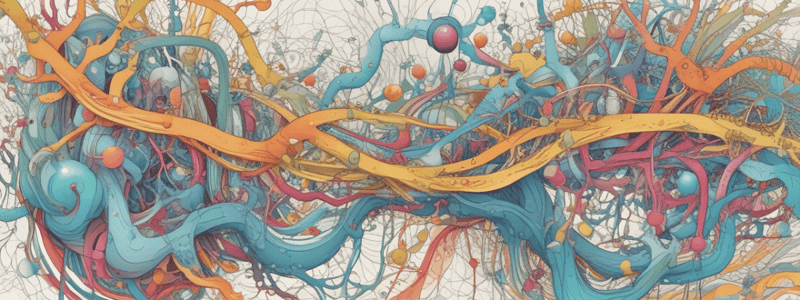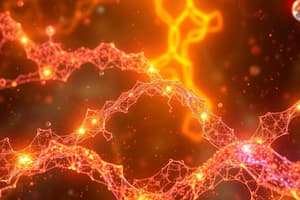Podcast
Questions and Answers
What is the primary function of an enzyme in a biological reaction?
What is the primary function of an enzyme in a biological reaction?
- To change the substrate specificity of a reaction
- To speed up the rate of a reaction without altering the final equilibrium (correct)
- To slow down the rate of a reaction
- To alter the final equilibrium between reactants and products
What type of bonds stabilize the structure of an enzyme?
What type of bonds stabilize the structure of an enzyme?
- Many weak bonds including H-bonds, electrostatic salt bridges, Van der Waals and hydrophobic interactions (correct)
- Ionic bonds
- Weak hydrogen bonds
- Strong covalent bonds
What is the term for the maximum rate of an enzyme-catalyzed reaction?
What is the term for the maximum rate of an enzyme-catalyzed reaction?
- Vmax (correct)
- Initial velocity
- Km
- Michaelis-Menten constant
What is the effect of competitive inhibition on the Km value of an enzyme?
What is the effect of competitive inhibition on the Km value of an enzyme?
What is the term for the phenomenon where a substrate binds to an allosteric site, causing a conformational change that affects the active site?
What is the term for the phenomenon where a substrate binds to an allosteric site, causing a conformational change that affects the active site?
What is the term for the process by which an enzyme is irreversibly inactivated by a molecule?
What is the term for the process by which an enzyme is irreversibly inactivated by a molecule?
What is the equation that describes the kinetics of an enzyme-catalyzed reaction?
What is the equation that describes the kinetics of an enzyme-catalyzed reaction?
What is the term for the initial rate of an enzyme-catalyzed reaction, measured under conditions where the substrate is present in excess?
What is the term for the initial rate of an enzyme-catalyzed reaction, measured under conditions where the substrate is present in excess?
What is the main limitation of the lock and key theory proposed by Emil Fisher?
What is the main limitation of the lock and key theory proposed by Emil Fisher?
What is the primary advantage of the induced fit theory over the lock and key theory?
What is the primary advantage of the induced fit theory over the lock and key theory?
What is the role of weak interactions in the induced fit theory?
What is the role of weak interactions in the induced fit theory?
What is the primary function of the induced fit in enzyme catalysis?
What is the primary function of the induced fit in enzyme catalysis?
What is the main reason why enzymes are complementary to the transition state of a reaction?
What is the main reason why enzymes are complementary to the transition state of a reaction?
What would happen if the 'Stickase' enzyme were complementary to the metal stick in its ground state?
What would happen if the 'Stickase' enzyme were complementary to the metal stick in its ground state?
What is the main consequence of an enzyme stabilizing the transition state of a reaction?
What is the main consequence of an enzyme stabilizing the transition state of a reaction?
Why is it important for enzymes to be complementary to the transition state of a reaction?
Why is it important for enzymes to be complementary to the transition state of a reaction?
What is the rate of an enzyme-catalyzed reaction measured by?
What is the rate of an enzyme-catalyzed reaction measured by?
What is the assumption of the Michaelis-Menten reaction model?
What is the assumption of the Michaelis-Menten reaction model?
What is the effect of high substrate concentration on the reaction rate of many enzymes?
What is the effect of high substrate concentration on the reaction rate of many enzymes?
Which of the following is a characteristic of enzyme kinetics?
Which of the following is a characteristic of enzyme kinetics?
What is the function of pepsin?
What is the function of pepsin?
What is the term for the study of the rate of an enzyme-catalyzed reaction?
What is the term for the study of the rate of an enzyme-catalyzed reaction?
What is the ES complex in the Michaelis-Menten reaction model?
What is the ES complex in the Michaelis-Menten reaction model?
What is the effect of pH on enzyme reactions?
What is the effect of pH on enzyme reactions?
What is the primary function of ligases in biochemical reactions?
What is the primary function of ligases in biochemical reactions?
What is the net result of the reaction catalyzed by lactate dehydrogenase?
What is the net result of the reaction catalyzed by lactate dehydrogenase?
What is the function of transferases in biochemical reactions?
What is the function of transferases in biochemical reactions?
What is the primary function of hydrolases in biochemical reactions?
What is the primary function of hydrolases in biochemical reactions?
What is the net result of the reaction catalyzed by trypsin?
What is the net result of the reaction catalyzed by trypsin?
What is the primary function of lyases in biochemical reactions?
What is the primary function of lyases in biochemical reactions?
Which of the following enzymes is an example of an oxidoreductase?
Which of the following enzymes is an example of an oxidoreductase?
What is the net result of the reaction catalyzed by alanine aminotransferase?
What is the net result of the reaction catalyzed by alanine aminotransferase?
Which of the following enzymes is an example of a hydrolase?
Which of the following enzymes is an example of a hydrolase?
What is the common feature of all oxidative reactions catalyzed by oxidoreductases?
What is the common feature of all oxidative reactions catalyzed by oxidoreductases?
What is the assumption behind the Michaelis-Menten equation?
What is the assumption behind the Michaelis-Menten equation?
What is the relationship between Km and Vmax when V0 = 0.5Vmax?
What is the relationship between Km and Vmax when V0 = 0.5Vmax?
What is the steady-state assumption in the Michaelis-Menten equation?
What is the steady-state assumption in the Michaelis-Menten equation?
What is the unit of Km?
What is the unit of Km?
What is the expression for Km in terms of the rate constants?
What is the expression for Km in terms of the rate constants?
What is the significance of V0 in the Michaelis-Menten equation?
What is the significance of V0 in the Michaelis-Menten equation?
What is the condition for the Michaelis-Menten equation to be applicable?
What is the condition for the Michaelis-Menten equation to be applicable?
What is the physical significance of the Michaelis-Menten equation?
What is the physical significance of the Michaelis-Menten equation?
Flashcards are hidden until you start studying
Study Notes
Enzyme Structure and Properties
- Enzymes are proteins composed of one or more polypeptide chains folded into a complex 3-dimensional shape.
- Enzyme structure is stabilized by many weak bonds, including hydrogen bonds, electrostatic salt bridges, Van der Waals, and hydrophobic interactions.
- Enzymes are biological catalysts that speed up the rate of a reaction without altering the final equilibrium between reactants and products.
- Enzymes are extremely efficient, with some enzymes catalyzing reactions at a rate 10^14 times faster than the uncatalyzed reaction.
Enzyme Active Site and Lock-and-Key Theory
- The lock-and-key theory, proposed by Emil Fischer in 1884, suggests that enzymes are complementary to their substrate, like a lock and key, to explain the high specificity of enzymes.
- However, this theory is misleading, as it does not account for the flexibility of enzymes.
- The induced fit theory, proposed by Daniel Koshland in 1958, suggests that enzymes undergo conformational changes upon substrate binding, which brings specific functional groups within the enzyme into the proper position to catalyze the reaction.
Transition State and Enzyme Catalysis
- A transition state is an unstable, high-energy intermediate in a chemical reaction.
- Stabilizing the transition state is one way that enzymes can speed up a reaction.
- Enzymes must be complementary to the transition state to effectively catalyze the reaction.
Enzyme Classification
- Enzymes can be classified into six categories based on the type of reaction they catalyze:
- Oxidoreductases (catalyze oxidation/reduction reactions)
- Transferases (catalyze the transfer of functional groups from one substance to another)
- Hydrolases (catalyze the formation of two products from a substrate by hydrolysis)
- Lyases (catalyze non-hydrolytic addition or removal of groups from substrates)
- Ligases (catalyze the formation of new bonds between molecules)
Enzyme Kinetics
- The study of the rate of an enzyme-catalyzed reaction and how it varies with different substrate concentrations and the effects of inhibitors.
- The reaction rate is the increase in the amount of product formed per unit time or the decrease in the amount of substrate per unit time.
- Many enzymes display saturation kinetics, which can be described by the Michaelis-Menten equation.
Michaelis-Menten Equation
- The Michaelis-Menten equation describes the rate of an enzyme-catalyzed reaction:
- V0 = Vmax[S] / (Km + [S])
- Where V0 is the initial reaction velocity, Vmax is the maximum velocity, Km is the Michaelis constant, and [S] is the substrate concentration.
- The Michaelis-Menten equation assumes that the substrate concentration is much higher than the enzyme concentration, and that the initial velocity is used to measure the reaction rate.
Km and [S] Relationship
- There is a special relationship between Km and [S] when V0 = 0.5Vmax:
- Km = [S] when V0 = 0.5Vmax
Studying That Suits You
Use AI to generate personalized quizzes and flashcards to suit your learning preferences.




